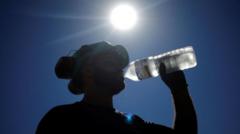With the climate crisis escalating, there is an urgent need for workplace adaptations to combat the dangers of extreme heat.
The World Health Organization's latest report highlights the escalating risks faced by workers due to rising temperatures as a direct consequence of climate change. It draws attention to the urgent need for governments, employers, and the workforce to work in unison to prepare for and tackle heat stress. This report marks the first time since 1969 that the WHO has addressed this critical issue specifically in the workplace.
The WHO's findings indicate that millions of workers, especially in industries like construction and agriculture, are increasingly vulnerable to heat illness. The report warns that exposure to prolonged temperatures above 38°C can lead to serious health issues such as heat-related stress, dehydration, and in severe cases, stroke and kidney failure. With the threat of heatwaves becoming a recurrent problem globally, it becomes vital for adaptation measures to be urgently put into place to protect workers' wellbeing and maintain productivity.
Tackling this issue is integral for both health and economic reasons. For instance, data shows that for every degree rise in temperature above 20°C, worker productivity drops by 2%. The situation is compounded by higher accident rates during heatwaves, as seen in Switzerland this year, where workers faced increased risks of accidents when temperatures rose above 30°C.
In response, some European countries are taking steps to protect workers. Italy recently adopted emergency measures to halt work during the hottest parts of the day, while specific cantons in Switzerland temporarily paused construction work during severe heat. These proactive decisions, however, face challenges, as many construction companies remain under pressure to meet deadlines.
Moreover, the risks extend beyond workplace environments; vulnerable populations like the elderly and children are also significantly impacted by heat. In Germany, schools can declare “Hitzefrei” (heat-free) days, but rising temperatures now happen so frequently that such measures are becoming harder to enforce.
To adapt effectively, the report emphasizes the need for inclusive consultation involving governments, trade unions, the education sector, and healthcare agencies. Krech also raises considerations such as whether current school uniforms are suitable for extreme heat, highlighting the need for creative solutions in adaptation.
Nonetheless, implementing necessary adaptations for workplaces, schools, and hospitals will require substantial investments. Krech cautions that neglecting this aspect due to budget constraints could lead to long-term economic consequences, such as decreased productivity and increased health issues among workers.
As the climate crisis continues to evolve, addressing the health and productivity implications of extreme heat is not just sensible — it is essential. Countries must prioritize climate adaptations now, or they may face dire repercussions in terms of health and economic productivity in the future.
The World Health Organization's latest report highlights the escalating risks faced by workers due to rising temperatures as a direct consequence of climate change. It draws attention to the urgent need for governments, employers, and the workforce to work in unison to prepare for and tackle heat stress. This report marks the first time since 1969 that the WHO has addressed this critical issue specifically in the workplace.
The WHO's findings indicate that millions of workers, especially in industries like construction and agriculture, are increasingly vulnerable to heat illness. The report warns that exposure to prolonged temperatures above 38°C can lead to serious health issues such as heat-related stress, dehydration, and in severe cases, stroke and kidney failure. With the threat of heatwaves becoming a recurrent problem globally, it becomes vital for adaptation measures to be urgently put into place to protect workers' wellbeing and maintain productivity.
Tackling this issue is integral for both health and economic reasons. For instance, data shows that for every degree rise in temperature above 20°C, worker productivity drops by 2%. The situation is compounded by higher accident rates during heatwaves, as seen in Switzerland this year, where workers faced increased risks of accidents when temperatures rose above 30°C.
In response, some European countries are taking steps to protect workers. Italy recently adopted emergency measures to halt work during the hottest parts of the day, while specific cantons in Switzerland temporarily paused construction work during severe heat. These proactive decisions, however, face challenges, as many construction companies remain under pressure to meet deadlines.
Moreover, the risks extend beyond workplace environments; vulnerable populations like the elderly and children are also significantly impacted by heat. In Germany, schools can declare “Hitzefrei” (heat-free) days, but rising temperatures now happen so frequently that such measures are becoming harder to enforce.
To adapt effectively, the report emphasizes the need for inclusive consultation involving governments, trade unions, the education sector, and healthcare agencies. Krech also raises considerations such as whether current school uniforms are suitable for extreme heat, highlighting the need for creative solutions in adaptation.
Nonetheless, implementing necessary adaptations for workplaces, schools, and hospitals will require substantial investments. Krech cautions that neglecting this aspect due to budget constraints could lead to long-term economic consequences, such as decreased productivity and increased health issues among workers.
As the climate crisis continues to evolve, addressing the health and productivity implications of extreme heat is not just sensible — it is essential. Countries must prioritize climate adaptations now, or they may face dire repercussions in terms of health and economic productivity in the future.




















